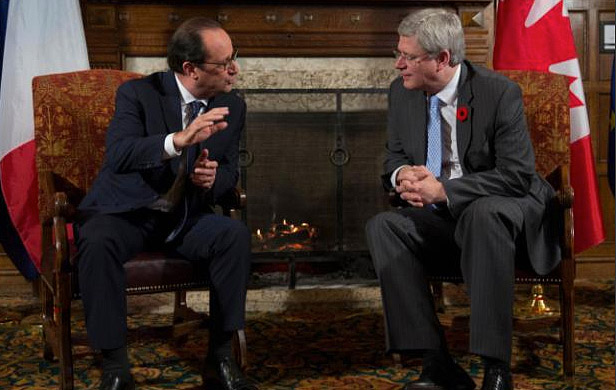
The pressure is building to reduce global carbon emissions. At each meeting of the United Nations’ Conference of the Parties (COP), the urgency becomes more palpable.
The Lima meeting of COP 20 in December, 2014, failed to reach the preliminary commitments necessary for the binding international agreements expected at the COP 21 meeting in Paris in December, 2015. France is getting nervous because its reputation will be sullied if the Paris COP is a failure — French President Francois Holland made this very clear to Prime Minister Stephen Harper during an autumn 2014 visit to Ottawa.
With the Kyoto Protocol expired and without a binding replacement agreement from subsequent COP meetings in Cancun, Copenhagen and Durban, the default position has been for individual countries, provinces and communities to do the best they can to reduce emissions. This approach has been helpful but not sufficient. Almost all of Canada’s reduced emissions have come from provincial initiatives, not federal. Most other countries have been unable to meet their voluntary reduction targets.
Economy decoupling from fossil fuels…slowly
Meanwhile, international agencies have been carefully charting carbon emissions for hopeful signs. But these signs are rare. In 2012, for example, the increase in carbon emissions of 1.4% was less than the increase in GDP of 3.4%, indicating that the world economy is beginning to decouple from fossil fuels by becoming more efficient. In 2013, carbon emissions crept up by 2.3% while GDP rose by 3.3%.
In 2014, emissions rose by 2.5% while GDP increased by 3.3%. If climate change is going to be slowed and reversed, however, total global emissions must not just trail GDP but must be reduced by a yearly average of at least 2.5% until all emissions reach zero on or before 2100. Any delays now will mean steeper future reductions.
Efficiency not enough
Two lessons are to be learned from these statistics. First, efficiency alone in a world of expanding GDP is unlikely to bring about sufficient carbon emission reductions. And second, although the accomplishment of efficiency is mostly symbolic, it is nonetheless important. Every factory that uses less energy reduces emissions. The same is true for every new car that burns less fuel, and for every LED bulb that replaces an incandescent one. Statistics confirm that every individual choice, no matter how small, contributes to measurable environmental benefits.
Another development is promising. The prestigious journal, Nature Geoscience, recently reported that more than half of all known fossil fuel reserves on the planet will have to remain unburned if we are to avoid dire climate change. With this realization, hundreds of the world’s financial institutions, foundations and universities are beginning to transfer billions of dollars of investments from coal, oil and gas to renewable energies.
Time is short
But time is crucial and the numbers are daunting. Global yearly carbon dioxide emissions are now, as of the beginning of 2015, about 37 gigatonnes. To translate this number into slightly more approachable terms, this is 37,000 million tonnes. The wisps of smoke drifting up from a hunter-gatherer’s cooking fire or from a solitary country cottage makes our planet seem very large. But 37,000,000,000 tonnes of carbon dioxide is a declaration that our fires have grown sufficiently large to influence the planet we occupy. So we should not be surprised if our emissions are changing climate, acidifying oceans, melting ice caps, raising sea levels, driving species to extinction.
These consequences are being confirmed with sobering statistics:
- Six months ago, the US National Oceanic and Atmospheric Administration measured the world’s average temperature at a new record of 16.2°C, 1.3°C higher than than the 20th century average. The 10 hottest years since 1880 occurred in the 15 years between 1998 and 2013; none occurred before 1880.
- The pre-human extinction rate for species was 0.1 per million per annum; the present rate is somewhere between 100 and 1,000, a rate that is 1,000 to 10,000 times normal.
- For centuries prior to 1800 sea level rise was essentially zero; from 1900 to 2000 it was 1.7 mm per year; from 1990 to 2013 it increased to 3 mm. The total sea level rise by 2100 is expected to be about 0.5 m. But many variables could increase this number. Earth’s average atmospheric carbon dioxide concentrations are expected to reach 400 ppm sometime in 2015. The last time concentrations were this high, about 3 million years ago, sea levels stabilized at about 10 metres above present levels. This suggests sea level rise will be continuous for centuries, presenting colossal challenges for coastal cities, settlements and agriculture.
The importance of reducing carbon dioxide emissions continues to increase exponentially. This means that 2015 will be an even more crucial year for taking corrective action. The longer we procrastinate, the more radical and difficult must be our future reduction measures.
If our inclination to inaction continues, we may reach a time when the problem of climate change is unstoppable and unsolvable. Unfortunately, we don’t know when this time will occur. We may have already reached and passed it. But we can be virtually certain that continued delays will only make the challenges and the consequences increasingly difficult — for our climate, for our oceans, for innumerable species, and for civilization as we know it. Whether 2015 becomes a year for optimism remains uncertain.


Global Temperature Trend Update: June 2015
Global climate trend since Nov. 16, 1978: +0.11 C per decade
http://reason.com/blog/2015/07/06/global-temperature-trend-update-june-201
Come on people…wake up and realize you have been had….by an international government sponsored scam. They want more control, more poverty and fewer people.
As solar activity falls, we should be preparing for shorter growing seasons and colder winters.
Diminishing solar activity may bring new Ice Age by 2030
Lomonosov Moscow State University Press Release
http://iceagenow.info/2015/07/university-press-release-warns-that-falling-solar-activity-may-bring-new-ice-age/
We are alive because we breath oxygen. The planet was not always hospitable. Through photosynthesis(energy of the sun converted to energy) plants have stored carbon into the ground and have released oxygen into the atmosphere. This did not just happen over night it took an extremely long time. For over 100 years and soon to be 200 years humans will have taken billions of years of this stored carbon and oxygen and mixed it back together which is poisoning to every animal on the planet. At the same time we are doing this we are also destroying our planets ability to continue storing the carbon from the atmosphere back into the ground from deforestation and massive oil spills in our ocean which kills aquatic plant life. Plants need to die and decay underneath new plants that take there place because the prevent the co2 from the dead plant from being release into the atmosphere. You can’t just replant a bunch of trees and then cut them down 20 years later and say they supply more oxygen then old trees. The c02 just gets released back into the atmosphere as soon as you cut the forest down. If humans plucked a ripe tree here and there. The surrounding trees would still be able to absorb the co2 being releases from the rotting trunks, vegetation, animals bugs and bug shit. As it stands even if humans stopped digging up and releasing carbon the atmosphere concentrations would stay the same or increase. Theres 7 billion people breathing 02 and breathing out co2 straight into the atmosphere with no trees to absorb it. How bought 7 billion human bodies that are cremated that’s like a gallon of gas for each body plus the body itself which is mostly carbon being released sight Into the atmosphere. 🙂 if the planet was to last with humans we would have to just live and die in the forest.
a SOLAR ENERGY CAR made by amateurs have crossed Australia. Why CAR´S FACTORIES do not want to know that?. Petroleum´s economic interests. Shame politicians
http://www.cbc.ca/news/world/drinking-water-trucked-into-montana-city-after-oil-spill-1.2919086
If we should have learned one thing from the trio of reports released this week it’s the futility of treating climate change as a standalone problem that can be addressed in isolation of its related challenges. Yes, we must decarbonize our economies but even that would be just scratching the surface of what ails us. Our constantly growing population is already using renewable resources at more than 1.5 times their renewal rate. We’re dependent on consuming more than what exists and it’s a growing dependency. In the process we’re discharging more waste and contamination, especially phosphorous and nitrogen discharge, than our planet can bear. Yet we cannot break our slavish pursuit of constant, exponential growth.
There’s a question that we, as individuals, as societies, as governments, cannot bring ourselves to ask: what must we do to live in harmony with our environment, our planet, our one and only biosphere? We won’t ask the question because we already know we can’t accept the answer.
At times it seems that we’ve adopted the worst characteristics of a malignancy.
So very true, MoS. To go a bit further, aside from this general denial of the external realities and their impending economic and environmental consequences, too many of us have become slavish to allowing overgrown agencies and isms, not to mention the pernicious psychology that comes with circular if often veiled assumptions about abundance and scarcity, dictate the meaning of good health, good wealth, liberty and happiness for ourselves and our communities. All the time and money we spend as modern societies on mental health, personal therapies and New Age spirituality needs to find its way back to the land base and into the living body politic. And on a happy note to the otherwise often grim news and statistics, it seems to me by way of alternative news sources that more common folk than ever are taking a courageous stand for a sane and sustainable ecology in the places they live all the world over if sometimes against great odds. It was not like this thirty years ago when typically it were the experts, lobbyists and militant activists – to whom we should all feel indebted – were making the headlines. I find this reassuring and all the more reason to keep addressing the urgency in firm, earnest, and uncompromising as need be, terms.
“Six months ago, the US National Oceanic and Atmospheric Administration measured the world’s average temperature at a new record of 16.2°C, 1.3°C higher than than the 20th century average. The 10 hottest years since 1880 occurred in the 15 years between 1998 and 2013; none occurred before 1880.”
I should think that since 1880, none of the hottest years occurred before that same year. Typo maybe?